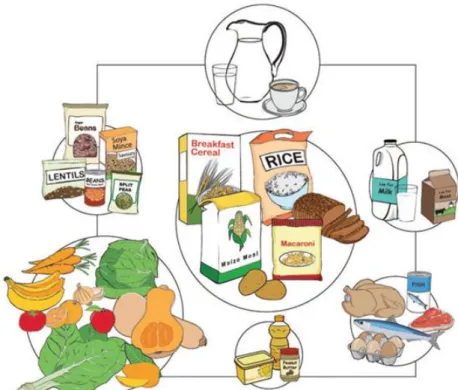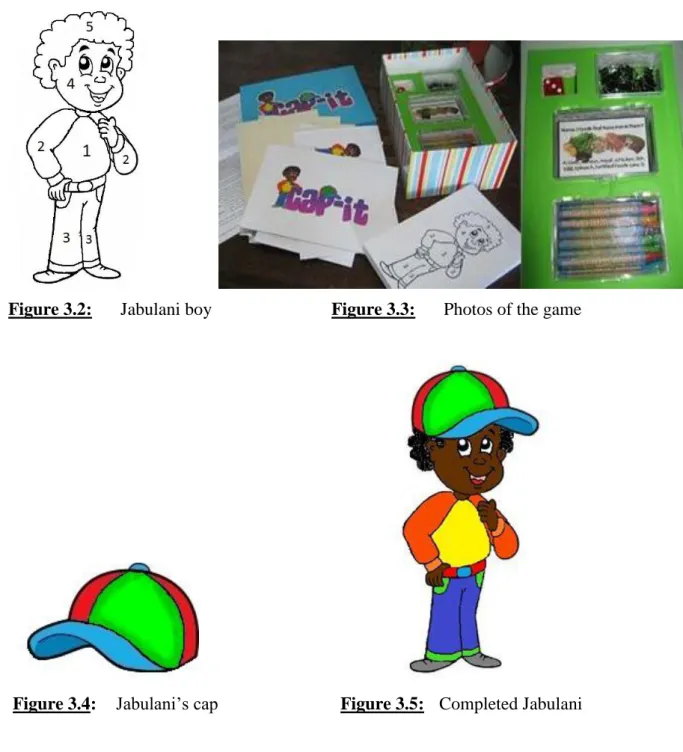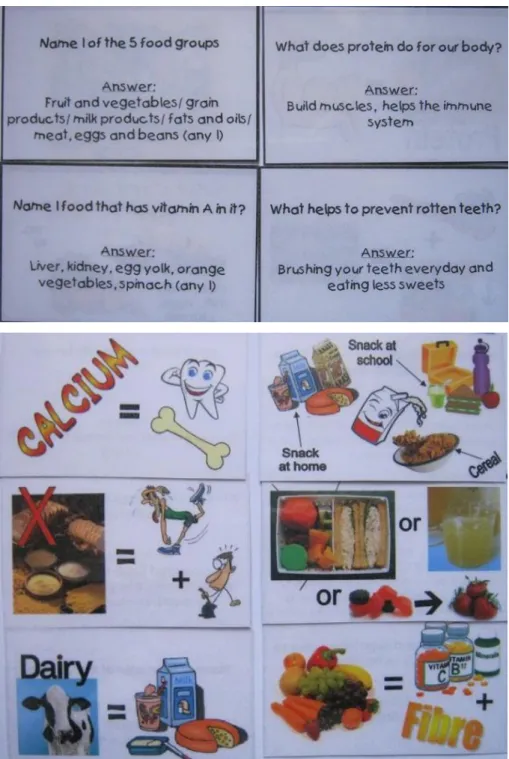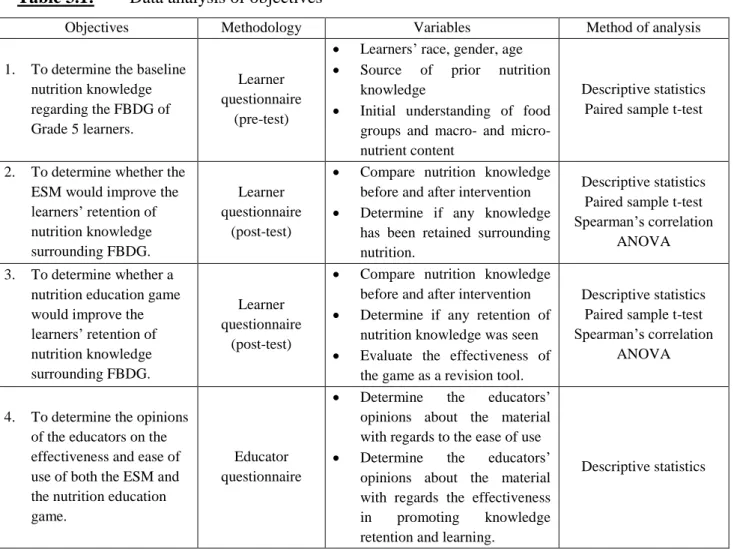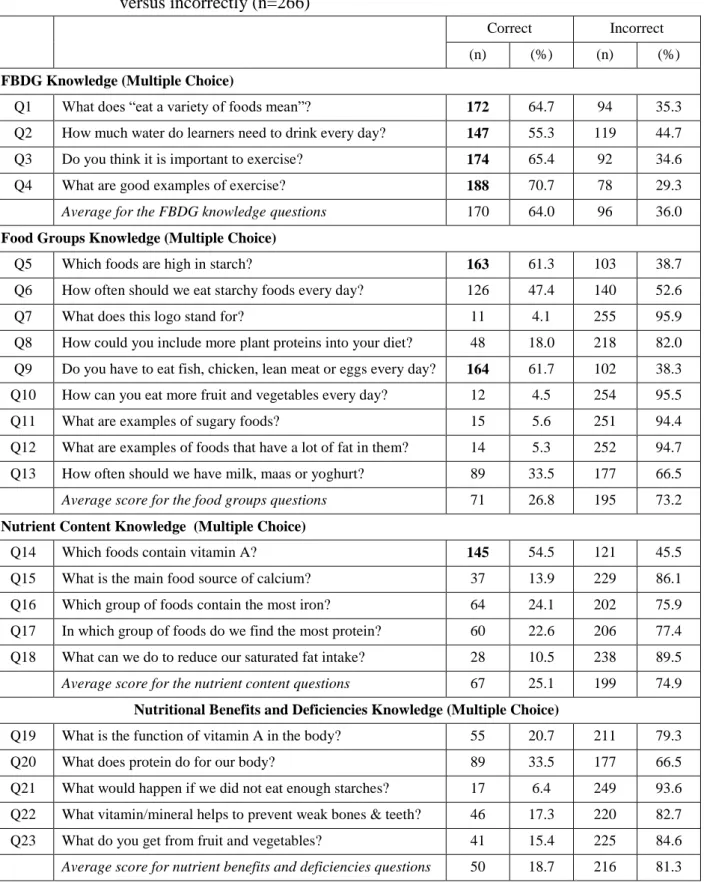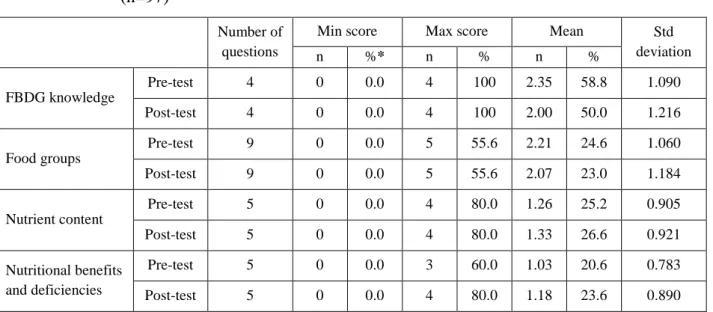60 Table 4.10: Importance of each section for the group's play before and after. 60 Table 4.11: Number of students who answered correctly and the associated percentage for the game group (n=89).
INTRODUCTION, THE PROBLEM AND ITS SETTING
- Background to the importance of the study
- Statement of the problem
- Study objectives
- Type of study
- Study constraints
- Assumptions
- Definition of terms
- Abbreviations
- Hypotheses
- Summary
- Dissertation overview
The answers to the questions were a true reflection of the students' current knowledge during their studies. A guide for teachers to incorporate food-based nutrition guidelines by providing fun activities for students as part of the CAPS curriculum.
REVIEW OF THE RELATED LITERATURE
Prevalence of over- and under-nutrition in South Africa
However, the MDG country report issued in 2010 suggested that despite the improvements, this MDG will not be achieved by 2015 due to the large number of people living without education or resources (UNDP 2010). This ties in with the second MDG which looks at providing primary education to all.
Development and use of guidelines and food guides
- North America
- Europe and Asia
- South Africa
This guideline has been changed from "the basis of most meals" to "part of most meals" to reflect the South African context. Originally, this guideline came under the meat and eggs guideline, but it was changed to a separate guideline, as it is also a cheap source of high-biodegradable protein and should therefore be eaten every day.
Benefits of healthy food choices for children
Methods must be developed to help take the information available in the FBDG and make it usable for the population (SANHANES-1 2012). This can encourage a healthier generation that is able to make better food choices from a young age.
Nutrition education as a means to promote healthy food choices
- Two theories regarding how knowledge is retained
Over the past decade, NE programs have been divided into two different approaches (Contento, Balch, Bronner, Paige, Gross, Bisignani et al. 1995). This is often not the case when only a few specific behaviors are selected and taught, as in the behavioral approach.
Factors influencing the development of an effective nutrition education programme
- Adequate time and intensity for change
- Family involvement
- Community involvement
- Self-evaluation
- Modifying the school environment
The teenagers in the Jackson et al (2009) study were able to learn through performance because they were expected to discuss ideas about nutrition and physical activity before each lesson and then evaluate their theater scripts at the end (Jackson et al 2009). In the study conducted by Dollahite et al (1998), the researchers found that the NE program together with a number of supplementary programs helped to change the canteen menu to include more healthy options which in turn had positive effects on the learners had (Dollahite et al, 1998) ).
Developing a nutrition education tool
The school as a setting for nutrition education
- Teaching Grade 5 learners
These factors must be considered by the teacher to determine how best to help each student develop within the classroom environment (Powers et al. 2005). They should be taught in a variety of ways and integrate all areas of learning into a single lesson (EST 2008; Powers et al. 2005).
Nutrition education programmes used internationally
- Alternative forms of nutrition education
- Nutrition education as a game or activity
In the UK, Lakshman et al (2010) conducted a study that specifically looked at using a game to improve nutrition knowledge in children. The results showed that there was a statistical significance in the increase in vegetables eaten by the students.
Nutrition education programmes in South Africa
- The current state of the South African curriculum
- Local programmes and tools
Short-term results indicated a significant improvement in the overall mean nutrition knowledge score (13.4%), but a decline in student nutrition knowledge was seen at three months. A pre- and post-test was conducted to determine students' nutrition knowledge before and after the intervention, and a 24-hour recall was used to assess students' food choices.
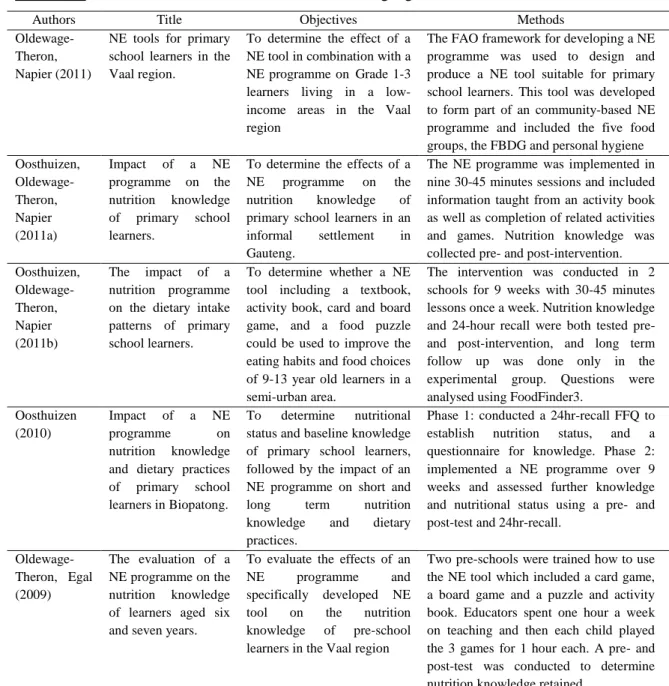
Conclusion
STUDY METHODOLOGY
- Study design
- Study population and sample selection
- Study population
- Sample selection
- Survey methods and material
- Questionnaire development
- Development of the game
- Development of the ESM
- Fieldworker training
- Data quality
- Reliability
- Validity
- Pilot study
- Data analysis
- Ethical considerations
- Summary
Nutrition knowledge questions - These questions made up the majority of the questionnaire but were limited to 23 questions. The responses helped the researcher gain insight into educators' opinions about play or ESM. Both Unilever and Ms Browne gave permission for the material to be used in this study and it was developed independently of the student questionnaire.
In this study, an expert panel was used to assess the validity of the questionnaire. To determine educators' opinions on the effectiveness and ease of use of the ESM game and nutrition education. The results of the students' questionnaire and the educator's questionnaire will be presented in the next chapter.
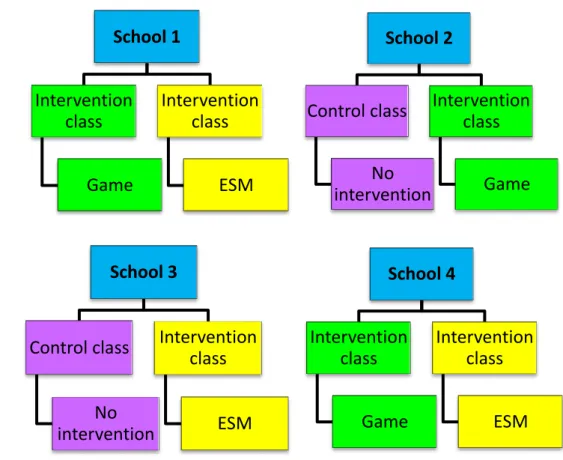
RESULTS
Sample characteristics
- Demographics
- Learners previous exposure to nutrition information
Results of the statistical analysis of the variables
- The baseline nutrition knowledge of Grade 5 learners regarding the FBDG
- Post-test nutrition knowledge of learners after the ESM intervention
- Post-test nutrition knowledge of learners after the game intervention
- Post-test nutrition knowledge of learners in the control group
- A comparison of all three groups
- Educators’ use and opinions of the ESM and the game
Only one question in the FBDG knowledge section showed an improvement of 10.3%, while 4 out of 9 questions in the food groups section showed an improvement. Three parts in the post-test showed an improvement in the mean score. Individual questions for the game showed that more than half of the questions increased the final score.
The responses to the individual questions in the control were fairly good, with students answering 13 out of 23 questions (56.5%) correctly in the posttest (Table 4.16). These results can be further extrapolated to individual questions, allowing for a more precise comparison of control, ESM, and play. These results show that the ESM proved to be quite ineffective, as many questions showed a deterioration in the nutrition knowledge of the students in this group.
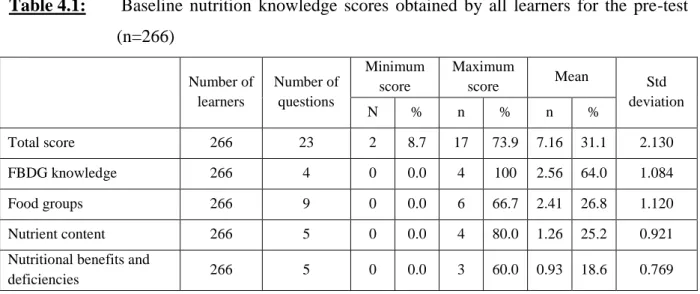
Summary of results
The relationship between the intervention method and the total score and the final outcome of the questionnaire was examined and a significant impact was found with a p-value of 0.002 and 0.030, respectively. This indicates that the game had a small but significant impact on students' knowledge retention. Teachers were also given questionnaires to determine their opinions on the use and effectiveness of the ESM and the game.
Overall, it was determined that the game was more effective than the ESM in retaining nutrition knowledge. However, although the game promoted knowledge retention, no significant improvements were made among students. Assessment of the previous results and possible explanations for the result will be dealt with in the following chapter.
DISCUSSION
- Demographic characteristics of the sample
- Baseline nutrition knowledge (pre-test)
- Learners’ knowledge of FBDG
- Learners’ knowledge of food groups
- Learners’ knowledge of nutrient content
- Learners’ knowledge of nutrient benefits and deficiencies
- Knowledge retention and improvement (post-test)
- ESM group
- Game group
- Control group
- Feedback from the educators
- Acceptance or rejection of the hypotheses
This may have happened in the schools involved in this study, which would have worsened their understanding of English and its use in the game and the questionnaire. Oosthuizen et al (2011a) suggested that an unexpected improvement could be observed in their control group due to students' friends attending another school involved in the intervention. A similar result could be the cause of the increase in control scores in this study, since the community is small and therefore may have participated during church or youth events.
The result was a significant increase in the knowledge, attitude and practice scores of the students in the intervention group of the study. The audit showed an improvement in three of the components, with the knowledge in the first component being retained. Similarly, Oosthuizen et al (2011b) and Lakshman et al (2010) found an improvement in the control group, but none with statistical significance.
CONCLUSION
Determination of baseline nutrition knowledge
The study showed that the students at baseline had a good understanding of basic nutritional concepts such as exercise and water consumption. However, when asked about nutrition in more detail, the level of nutrition knowledge decreased, indicating a poor understanding of topics related to the nutritional content of foods and benefits or deficiencies associated with these foods.
Nutrition knowledge retention after using the ESM
Nutrition knowledge retention after using the game
Opinions of the educators
Teachers commented on the effectiveness of the game as a way to improve language skills and promote group work.
Recommendations for future use
Study critique
- The game
- ESM and training
- The questionnaires
This can be done by providing 5 or 6 packs of cards and 5 or 6 cards, thus allowing the game to be played in small groups all at the same time. The game was meant to be played in small groups between lessons and not as a whole class, which is why this wasn't modified earlier. A longer intervention time would also have been beneficial as it would have allowed for a longer time to play the game and perhaps for information to be stored more effectively.
An important recommendation, although not agreed upon by the educators, would be to have improved training on the use of the ESM and how to play the game. However, the pictures used in the questionnaire and the game must be tested for understanding among the learners as they may have influenced the outcome of the study. Chronbach α statistical tests can be effective in determining the reliability of the measuring instrument and were not used in this study, making it a limitation.
Implications for further research
The evaluation of a nutrition education program on the nutrition knowledge of six and seven year old children. Impact of a nutrition education program on nutrition knowledge and dietary intake practices of primary school children in Biopatong. Nutrition education intervention improves nutrition knowledge, attitudes and practices of primary school children: A pilot study.
Impact of a nutrition education program on nutritional knowledge and practices of lower socio-economic communities in the Free State and Northern Cape. My research topic is titled “The Effectiveness of a Modified Nutrition Education Game Based on Nutritional Guidelines and Teacher Support Materials to Supplement Nutrition Education to Improve Knowledge Retention among Rural Year 5 Students Living in Sweetwaters, KwaZulu-Natal .”. I hereby confirm that I have been informed by UKZN Masters student Rebecca Esteves about the nature of her study “The effectiveness of an adapted Food Based Dietary Guideline nutrition education game and teacher support material in supplementing nutrition education to enhance the retention of knowledge in rural groups 5 students to improve, living in Sweetwaters, KwaZulu-Natal.”.
I am a student at the University of KwaZulu-Natal studying towards my Masters and my research topic is entitled "Effectiveness of a modified food-based dietary guidance nutrition education game and teachers support material to supplement nutrition education to improve knowledge retention in rural Class 5 students living in Sweetwaters, KwaZulu-Natal.” RE: REQUEST FOR PERMISSION TO CONDUCT RESEARCH INVOLVING YOUR CHILD I am a student at the University of KwaZulu-Natal studying towards my Masters and my research topic is entitled “The Effectiveness of a modified food-based dietary guidance nutrition education game and educators support material in supplementing nutrition education to improve retention of knowledge in rural grade 5 students living in Sweetwaters, KwaZulu-Natal.”.
